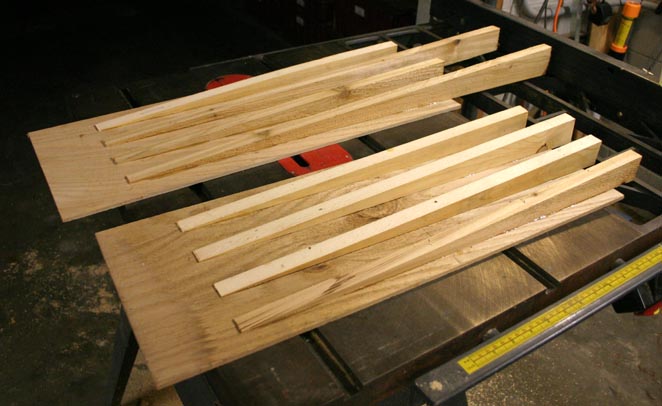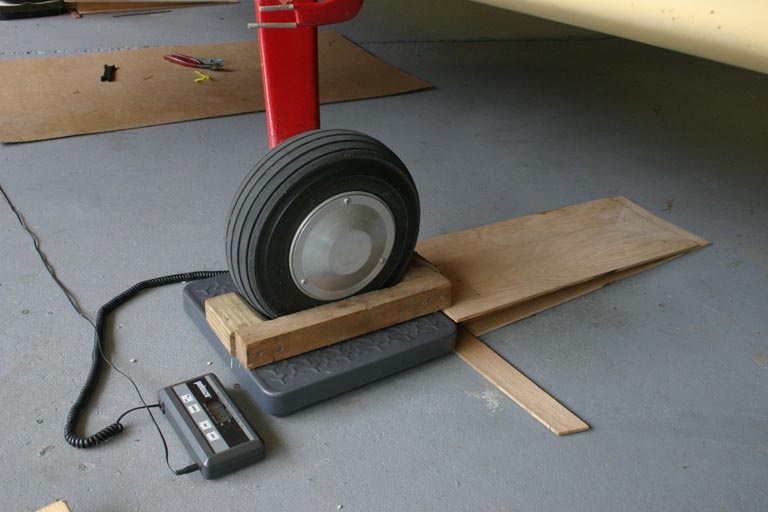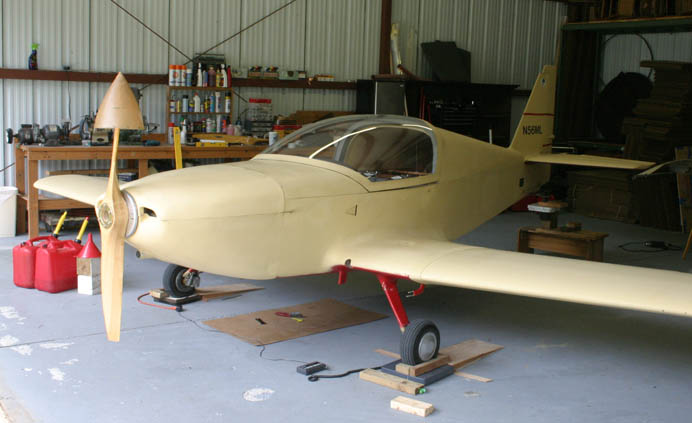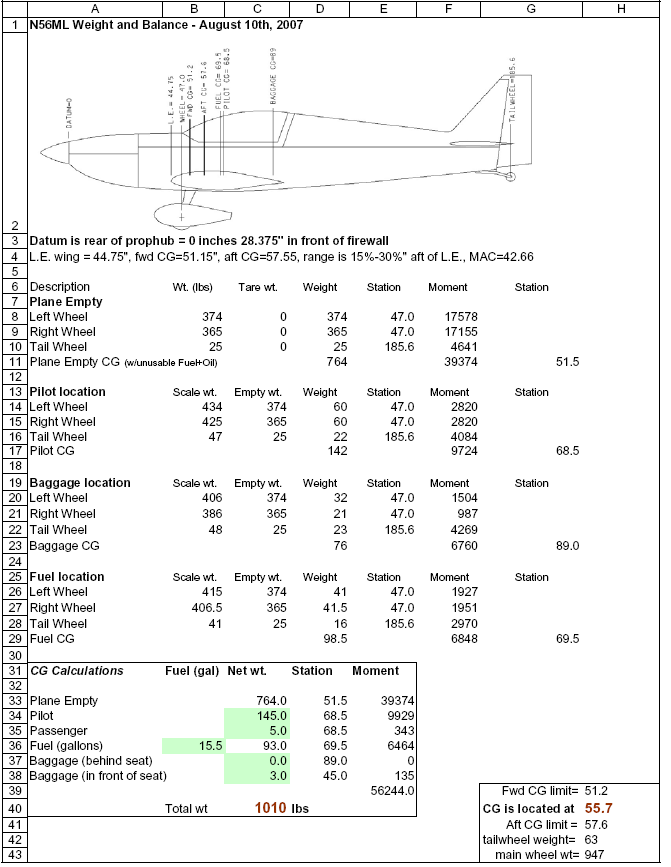N56ML Weight and Balance
N56ML Weight and Balance
Written August 2007, updated Oct 2007
In the Southern Baptist Church tradition in which I was brought up, they have what they call "testimonials", where you stand in front of the congregation and tell a story that either inspires or at least educates the masses, often at your expense. I was all ready to do that at the Gathering campfire, but it would have taken longer than I thought the average attention span was, and I thought it'd be better for the whole KRnet community to hear it as well. Here's mine, as far as aft CGs go:
A few months ago I was at work and checked my CorvAircraft email to discover a guy in northern Arkansas selling a Corvair engine for $75. I was looking for another case and heads to build my next engine, so I called him up to ask if I could check them out over the weekend. He said "sure, but the first guy that puts seventy-five bucks in my hand gets it". While I was still talking to him, I checked out Airnav.com and DUATS to see how long it would take me to get there at my average economy cruise speed....2 hours and twenty minutes. It was noon, so I asked if he could meet me at the Flat Ash airport at 3:00 with "the goods", and he said "I'll be there". So I took the rest of the day off and headed to the hangar.
It looked like a scene from "Emergency" or "Batman" as I drove up, raised the door, pulled the plane out, and was happy that I always fill it up before I leave it, ready for the next "KR fix" on a moment's notice. I showed up at two minutes before 3:00, and he was there with pick'em up and Corvair parts. I gave him his legal tender and proceded to load the pile into the KR. Now I know that theoretically you're supposed to do a CG analysis everytime you fly, but let's face it, my CG (unless I'm carrying passenger) is normally plus or minus a half inch when I'm just flying around, so I don't sweat that detail unless I'm flying to OSH with tent, sleeping bag, tie-downs, or a heavy passenger. I've carried passengers that weighed more than a Corvair engine, so the real challenge was keeping the CG reasonable. Besides, I didn't happen to have any scales available at the moment.
I put the four cylinder heads on the passenger side floor, and the pushrods and valve rockers under my feet. The only place big enough for the engine case was in the passenger seat, and even then I had to remove the four oil cover studs with some vice-grips (thanks to the guy who was in the nearby hangar working on his Kitfox). I put a bunch of other stuff behind the seats, with some of the lighter stuff occupying the third bay behind the main spar. The last thing to pile on was a full set of pistons/cylinders/rods, which I set on top of the engine case next to me and resting partially on the seat back shelf. And off I went.
As soon as I lifted off, I could tell this flight was going to be a little different, and it didn't take long to become quite a handful! When I got up to 100 mph or so on climbout, it became obvious that keeping the plane under control was going to be a full time job. The nose would start up, and I'd give it a little down stick, and it would dive radically. So I'd pull back a little, and a half second later I'd be aimed at the sky. This roller coaster ride went on for about a minute until I decided if I were just a tad slower on the draw, I was gonna be dead. I don't mean little stuff that would make me look bad, I mean violent pitch changes that put 2 g's on the meter just trying to maintain straight and level! Full adrenaline flow had been achieved, to be sure.
I knew it was an aft CG thing, so I took care of the easy stuff first...I slid the heavy piston/cylinder/rod box forward 'til it hit the instrument panel, about two feet. That made me start thinking that maybe I could handle it, especially if I could get back up to calm air, so I resigned myself to just live with it and climb on up to 9500' and get back home. Besides, when I get there I'll be lower on fuel and my CG will have moved forward another 3/4", so that'll be better, right? I still had the feeling that there was another shoe to drop though.
On the way back I debated whether or not I was going to attempt the 40' wide 2600' foot long strip at my home airport of Hazel Green, or if I'd do the smart thing and land hot at Meridianville's 6000' runway and unload all the heavy stuff, and come back for it later in the GTI. I figured it couldn't hurt to try M38 first, so I did. That was just about a tragic mistake in judgement. I landed about 15 mph hot to avoid a stall (which is marginal for a 2600' long runway in my plane), and even so, when I flared the tail dropped and the nose went up. This was the first time I broke out in a sweat and really didn't think I was going to make it. I wasn't real sure how that was going to turn out, but fortunately I had a big Corvair out there to pull me out of the fire! It was still dicey climbing out because I had to keep the nose low enough to climb, but still stay airborne. I was shaking on the climbout.
I got back up to speed and headed toward Meridianville, but immediately started another round of rearranging everything I could reach. All of the greasy cylinders, pistons, and rods came out of the box and went on the passenger floor, all the way to the rudder pedals. Grease on the carpet was no longer a concern. Then I flipped the passenger seat forward and started getting every thing else I could reach and sliding it up on the seat as far forward as possible. Then I tried a landing on the 6000' runway, 10 mph hot. It was a nice landing, despite being crosswind. I figured I could handle 10 mph hot at HG, to I flew back for another attempt. It was amazing how different the plane handled with the more forward CG.
I was hard on the brakes to get stopped, but I had room to spare on the end. When I got to the hangar I rearranged the Vair booty back to the original configuration and weighed the tailwheel, just for a data point. I could hardly lift it to get it on the scale. It was 75 pounds without me in the plane. It's normally about 25 with no pilot. Then I weighed the Corvair parts as I took them out. Only 191 pounds. I've flown passengers heavier than that. But a lot of these pounds were aft of the rear spar. I decided it was time to redo the weight and balance (see below).
The first thing I noticed was that it'd gained 35 pounds over the years, and most of it was aft. I remember when I was doing my original flight testing that the plane would do the phugoid thing, where it pretty much flew straight and level, but would slightly oscillate between up and down in the pitch axis, but would head back the other way within about 20 seconds or so. Lately it hadn't been that way at all...if it started up, it was going to keep going up until it stalled, and when it headed down, you were going to impact the ground and die sometime in the next minute or so. It turns out I'd been flying with an aft CG for a while, and really didn't even realize it.
But why was it so far aft? Although I'd deliberately moved it aft of centered (to make it faster) by moving my backup battery to the tail (and later doubling it's size), it really started out more aft that I'd originally thought. That's because my wing planform is different from most, in that the leading edge is straight all the way across. This is not because of some brilliant aerodynamic calculations that I'd performed, but because the spar shape I'd built on my plane was designed for the NLF(1)0115 airfoil that I was originally going to use, but when applied to the AS5046 the leading edge worked out to be straight across the airplane. This is not necessarily a bad thing, as now I have 2.5 more inches between MAC (mean aerodynamic chord) and the elevator (static margin), which improves pitch stability, all things being equal. When I did the original weight and balance for the DAR (Designated Airworthiness Representative), I was in a rush and forgot about this "little" detail, and used the RAF48/AS5046 planform to determine the MAC, from which the CG was set up. The difference was something like 2.5 inches, which, it turns out, is the difference in an airplane that simply needs a little constant attention and one that's a deathtrap!
I've always thought that it'd be obvious when the CG was too far aft, and I was right. What I didn't realize was how quickly you can get that way, and how hard the plane is to control. Make absolutely sure you know where your CG is before your first flight. It makes a world of difference...
After this incident, I thought it would be a good idea to recheck a few things; weight and balance, fuel totalizer calibration, etc. Over the two years that I've been flying N56ML, I've added XM weather, gone to a larger backup battery (back in the tail), upgraded transponder and radio, added stuff like a 110V inverter to power the laptop, a fuel transfer timer, canopy lock, and that sort of thing. Definitely time for a new weight and balance.

I finally broke down and built some ramps to help with the weight and balance operation. They are just simple wedges with quarter inch plywood top and bottom, with the bottom edges gradually tapered to ease rolling the plane on. The spinner was off the plane because I'd just come back from testing a different propeller, and I was too lazy to put it on properly, but it weighs far less than a pound. Perching it on top of the prop seemed like a reasonable compromise.

The ramps not only make it easier, but more accurate, as there is no side loading on the scales when the plane is rolled onto them, unlike what happens when you lower the wheel onto the scales with a jack. Readings are very repeatable this way.

Make sure the canopy is closed and the plane is level when weighing. Start with empty fuel tanks (run them dry while in flying attitude so that only "unusable" fuel is left). I'm only using one scale, as that's the only one I have that will go to 400 pounds, so I have to lower the tail, back the plane down the ramps, swap the scales to the other side, re-level, and make another measurment. This is a Pelouze scale from Office Depot (#935671 for $190). The one on the far side was a 300 pound bathroom scale that is way maxed out at the moment, and therefore useless, but was a convenient height for this. After balancing, it had a distinct bend to its top surface. The big chocks were swapped for small aluminum angles (and "zeroed out") for the actual weighing process.

Once empty weight is obtained with empty tanks, readings can be taken with the pilot in the seat, but you don't have to swap the scale side-to-side. Just use the accurate scales on the tail wheel, subtract the increase from the pilot's weight, divide that by two for the two wheels, and use those three numbers to determine the pilot's CG location. This weight and balance spreadsheet for N56ML allows you to plug in the scale readings for the three wheels to automatically determine CG location for empty airplane, then for the fuel, the pilot and passenger, and the baggage. These numbers are then used for overall aircraft CG determination down at the bottom. I added another couple of lines to then use the CG and total weight to show the weight on the tailwheel and mainwheels. You're welcome to copy this spreadsheet and use it, but be forewarned that you will have to change almost every number on it, even the CG limits (my MAC is not the same as a "normal" KR2S due to a straight leading edge, rather than slightly swept). But even if this spreadsheet was made for a stock KR2S, you'd still need to check and probably adjust every number on it anyway, it's a great head start, and it does work.
The photo at the top shows graphically where the aircraft CG envelope is located. To keep things balanced, weight must be distributed both in front of and behind the main spar.
If you don't have Excel, this is done just like the weight and balance form supplied with the KR plans, but it's just easier to use and has a few more functions. I guess if I were really dedicated, I'd make a weight and balance sheet that looked just like the one in the KR manual, but I'm not that dedicated at the moment.
As you can see from the spreadsheet, my CG for "normal" flying is just over 2/3 of the way aft, yet it still flies just fine. With a 200 pound passenger, it is almost exactly at the aft limit, and is still controllable, just a little more pitch sensitive. If you let go of the stick, it will gradually drift up or down, eventually climbing into a stall or entering a dive, but that's why there's a pilot in the plane. I flew this way for a year and really didn't notice it was aft, or that I had a problem.
I have also flown it two inches aft of the limit (see above), and I can tell you that I was lucky that I was able to redistribute the weight to get it in a range where I could still land it. I put 2g's on the meter just trying to make it fly straight and level! You don't want to go there, and over the years, several KR pilots have not come back from there.
The 1010 total weight is with 5 pounds of flight bag on the seat, four pounds of "essential" stuff behind the spar (like spare inner tube, screwdriver, pliers, canopy cleaner, etc), and a 3 pound laptop on the floor. I've moved my 12 pound "backup" battery from the tail (153" aft of the datum") to the back of the firewall, and swapped it for a much lighter UPS battery. That easily moved me back to the forward end of the range again. I really can't tell that there's any speed difference, but I can now let go of the stick and get successful phugoid behavior out of it. I flew for 20 minutes the other day by leaning left and right for roll control, and slightly moving my feet fore and aft for pitch control. That wouldn't have worked with an aft CG!
I'm also going to start loading down the baggage compartment a little at a time to try to determine at exactly what point the plane goes from stable to unstable, and also try to get some qualitative results as to what it's like with the CG 1" aft of "unstable", and that sort of thing. I can safely do that using "lead muffins", muffin sized chunks of lead made with molten lead poured into a muffin pan. These are small and easy to move (and confine), so it can be tested at altitude, and then they can be easily moved by hand from rear baggage to in front of the spar to get both ends of the spectrum on the same flight. I really should have done this sort of thing in the flight testing phase, but it flew just fine in the envelope as it was defined, so I haven't bothered to explore any past that until now. Don't make that mistake...
Return to Mark Langford's KR2S project.



